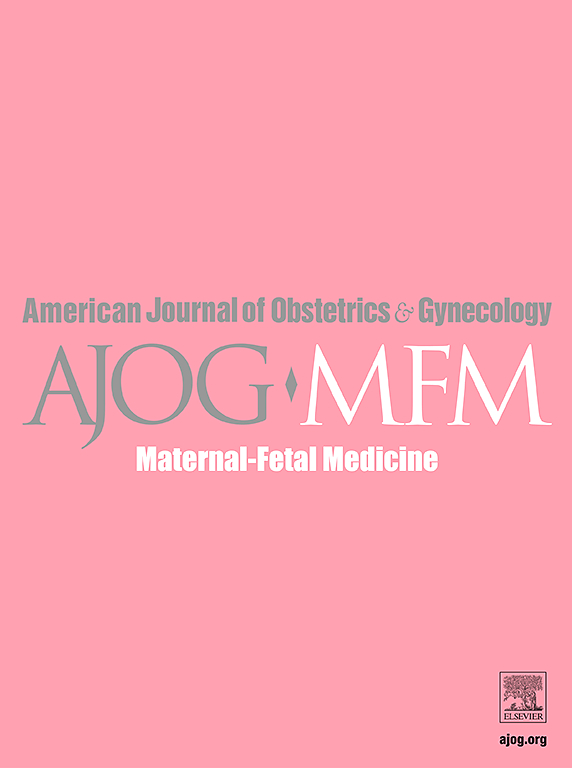活动限制与不良妊娠结局的风险。
IF 3.8
2区 医学
Q1 OBSTETRICS & GYNECOLOGY
American Journal of Obstetrics & Gynecology Mfm
Pub Date : 2024-10-01
DOI:10.1016/j.ajogmf.2024.101470
引用次数: 0
摘要
背景:尽管缺乏明确的数据显示妊娠结局有所改善,但限制活动是妊娠期因各种适应症而向患者提出的常见建议:研究设计:研究设计:对无胎儿妊娠结局研究进行二次分析:研究设计:对无子宫妊娠结局研究:待产母亲监测(nuMoM2b)前瞻性队列进行二次分析。从 2010 年 10 月至 2013 年 9 月,在 8 个地点对无妊娠期的单胎进行了随访。我们在 4 个时间点收集了人口统计学和临床数据,并就 22w0d-29w6d 和分娩时的 AR 建议对参与者进行了调查。我们排除了缺失 AR 和年龄数据的参与者。根据AR病史对参与者进行分组,APO包括:妊娠高血压(gHTN)、子痫前期/子痫、早产(PTB)和胎龄小(SGA)新生儿。使用单变量和多变量逻辑回归模型研究了AR与APO之间的关系,并对事先确定的APO风险因素进行了调整:在 10,038 名 nuMoM2b 参与者中,9,312 人符合纳入标准,1,386 人(14.9%)被建议使用 AR;与白人相比,黑人 [aOR 0.81 (95% CI 0.68-0.98)] 或西班牙裔 [aOR 0.73 (95% CI 0.61-0.87)] 参与者使用 AR 的可能性较低。总体而言,有 3197 人(34.3%)至少经历过一次 APO [有 AR 的参与者为 717 人(51.7%),无 AR 的参与者为 2480 人(31.3%)]。在对基线差异进行调整后,AR 组发生 gHTN [aOR 1.61 (95% CI 1.35-1.92)]、子痫前期/子痫 [aOR 2.52 (95% CI 2.06-3.09)]、先天性和自发性 PTB [aOR 2.98 (95% CI 2.41-3.69)]的几率增加,但不包括分娩 SGA 新生儿:结论:妊娠期AR与妊娠期高血压疾病和先天性脑瘫发生几率的增加有独立关联,但需要未来的前瞻性工作来确定潜在的因果关系。此外,与白人相比,黑人或西班牙裔受试者被建议进行 AR 的可能性要低得多。虽然AR并不是一种循证实践,但这些研究结果表明,偏见可能会影响哪些患者接受限制孕期活动的建议。本文章由计算机程序翻译,如有差异,请以英文原文为准。
Activity restriction and risk of adverse pregnancy outcomes
Background
Activity restriction is a common recommendation given to patients during pregnancy for various indications, despite lack of definitive data showing improvements in pregnancy outcomes.
Objective
To determine if activity restriction (AR) in pregnancy is associated with decreased odds of adverse pregnancy outcomes (APOs).
Study design
Secondary analysis of the Nulliparous Pregnancy Outcomes Study: Monitoring Mothers-to-Be (nuMoM2b) prospective cohort. Nulliparous singletons were followed at 8 sites from October 2010–September 2013. Demographic and clinical data were collected at 4 timepoints, and participants were surveyed about AR recommendations at 22w0d-29w6d and delivery. We excluded participants missing data on AR and age. Participants were grouped according to history of AR, and APOs included: gestational hypertension (gHTN), preeclampsia/eclampsia, preterm birth (PTB), and small for gestational age (SGA) neonate. Associations between AR and APOs were examined using uni- and multivariable logistic regression models adjusting for a priori identified APO risk factors.
Results
Of 10,038 nuMoM2b participants, 9,312 met inclusion criteria and 1,386 (14.9%) were recommended AR; participants identifying as Black (aOR 0.81 [95% CI 0.68–0.98]) or Hispanic (aOR 0.73 [95% CI 0.61–0.87]) were less likely to be placed on AR when compared to those identifying as White. Overall, 3,197 (34.3%) experienced at least one APO (717 [51.7%] of participants with AR compared to 2,480 [31.3%] participants without AR). After adjustment for baseline differences, the AR group had increased odds of gHTN (aOR 1.61 [95% CI 1.35–1.92]), preeclampsia/eclampsia (aOR 2.52 [95% CI 2.06–3.09]) and iatrogenic and spontaneous PTB (aOR 2.98 [95% CI 2.41–3.69]), but not delivery of an SGA neonate.
Conclusion
AR in pregnancy was independently associated with increased odds of hypertensive disorders of pregnancy and PTB, but future prospective work is needed to determine potential causality. Further, participants identifying as Black or Hispanic were significantly less likely to be recommended AR compared to those identifying as White. While AR is not an evidence-based practice, these findings suggest bias may impact which patients receive advice to limit activity in pregnancy.
求助全文
通过发布文献求助,成功后即可免费获取论文全文。
去求助
来源期刊

American Journal of Obstetrics & Gynecology Mfm
Medicine-Medicine (all)
CiteScore
7.40
自引率
3.20%
发文量
254
审稿时长
40 days
期刊介绍:
The American Journal of Obstetrics and Gynecology (AJOG) is a highly esteemed publication with two companion titles. One of these is the American Journal of Obstetrics and Gynecology Maternal-Fetal Medicine (AJOG MFM), which is dedicated to the latest research in the field of maternal-fetal medicine, specifically concerning high-risk pregnancies. The journal encompasses a wide range of topics, including:
Maternal Complications: It addresses significant studies that have the potential to change clinical practice regarding complications faced by pregnant women.
Fetal Complications: The journal covers prenatal diagnosis, ultrasound, and genetic issues related to the fetus, providing insights into the management and care of fetal health.
Prenatal Care: It discusses the best practices in prenatal care to ensure the health and well-being of both the mother and the unborn child.
Intrapartum Care: It provides guidance on the care provided during the childbirth process, which is critical for the safety of both mother and baby.
Postpartum Issues: The journal also tackles issues that arise after childbirth, focusing on the postpartum period and its implications for maternal health. AJOG MFM serves as a reliable forum for peer-reviewed research, with a preference for randomized trials and meta-analyses. The goal is to equip researchers and clinicians with the most current information and evidence-based strategies to effectively manage high-risk pregnancies and to provide the best possible care for mothers and their unborn children.
 求助内容:
求助内容: 应助结果提醒方式:
应助结果提醒方式:


